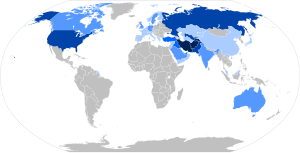ภาษาเปอร์เซียใหม่
หน้าตา
| ภาษาเปอร์เซียใหม่ | |
|---|---|
| فارسی نو, پارسی نو | |
 วลี ภาษาฟอร์ส เขียนเป็นอักษรวิจิตรเปอร์เซีย (แนสแทอ์ลีก) | |
| ประเทศที่มีการพูด |
|
| จำนวนผู้พูด | 70 ล้านคน (ไม่พบวันที่)[7] (รวมทั้งหมด 110 ล้านคน)[6] |
| ตระกูลภาษา | |
| รูปแบบก่อนหน้า | ภาษาเปอร์เซียโบราณ
|
| ระบบการเขียน | ชุดตัวอักษรเปอร์เซีย (อิหร่านและอัฟกานิสถาน) ชุดตัวอักษรทาจิก (ทาจิกิสถาน) ชุดตัวอักษรฮีบรู อักษรเบรลล์เปอร์เซีย |
| สถานภาพทางการ | |
| ภาษาทางการ |
|
| ผู้วางระเบียบ |
|
| รหัสภาษา | |
| ISO 639-1 | fa |
| ISO 639-2 | per (B) fas (T) |
| ISO 639-3 | fas |
| Linguasphere | 58-AAC (เปอร์เซียวงกว้าง) > 58-AAC-c (เปอร์เซียศูนย์กลาง) |
 บริเวณที่มีผู้พูดภาษาเปอร์เซียเป็นภาษาแม่ (รวมภาษาย่อย) | |
 โลกที่พูดภาษาเปอร์เซีย ข้อมูล ภาษาราชการ
ผู้พูดมากกว่า 1,000,000 คน
ผู้พูดระหว่าง 500,000–1,000,000 คน
ผู้พูดระหว่าง 100,000–500,000 คน
ผู้พูดระหว่าง 25,000–100,000 คน
ผู้พูดน้อยกว่า 25,000 คน / ไม่มี | |
ภาษาเปอร์เซียใหม่ (เปอร์เซีย: فارسی نو, อักษรโรมัน: Fārsī-ye No) มีอีกชื่อว่า ภาษาเปอร์เซียสมัยใหม่ (فارسی نوین) เป็นภาษาเปอร์เซียขั้นปัจจุบันซึ่งพูดกันมาตั้งแต่ช่วงคริสต์ศตวรรษที่ 8 ถึง 9 จนถึงปัจจุบันในเกรเตอร์อิหร่านและพื้นที่โดยรอบ ตามแบบแผนแบ่งออกเป็น 3 ขั้น คือ ภาษาเปอร์เซียใหม่ตอนต้น (คริสต์ศตวรรษที่ 8/9), ภาษาเปอร์เซียคลาสสิก (คริสต์ศตวรรษที่ 10–18) และภาษาเปอร์เซียร่วมสมัย (คริสต์ศตวรรษที่ 19 ถึงปัจจุบัน)
การจัดอันดับ
[แก้]ภาษาเปอร์เซียใหม่อยู่ในกลุ่มตะวันตกของกลุ่มภาษาอิหร่าน ซึ่งเป็นสาขาในกลุ่มภาษาอินโด-อิเรเนียนของตระกูลภาษาอินโด-ยูโรเปียน กลุ่มภาษาอิหร่านตะวันตกแบ่งออกเป็นสองกลุ่มย่อย คือ กลุ่มภาษาอิหร่านตะวันตกเฉียงใต้ที่ภาษาเปอร์เซียมีผู้พูดมากที่สุด และกลุ่มภาษาอิหร่านตะวันตกเฉียงเหนือที่ภาษาเคิร์ดมีผู้พูดมากที่สุด[10]
ดูเพิ่ม
[แก้]อ้างอิง
[แก้]- ↑ 1.0 1.1 1.2 Samadi, Habibeh; Nick Perkins (2012). Martin Ball; David Crystal; Paul Fletcher (บ.ก.). Assessing Grammar: The Languages of Lars. Multilingual Matters. p. 169. ISBN 978-1-84769-637-3.
- ↑ "IRAQ". Encyclopædia Iranica. สืบค้นเมื่อ 7 November 2014.
- ↑ "Tajiks in Turkmenistan". People Groups.
- ↑ Pilkington, Hilary; Yemelianova, Galina (2004). Islam in Post-Soviet Russia. Taylor & Francis. p. 27. ISBN 978-0-203-21769-6.
Among other indigenous peoples of Iranian origin were the Tats, the Talishes and the Kurds.
- ↑ Mastyugina, Tatiana; Perepelkin, Lev (1996). An Ethnic History of Russia: Pre-revolutionary Times to the Present. Greenwood Publishing Group. p. 80. ISBN 978-0-313-29315-3.
The Iranian Peoples (Ossetians, Tajiks, Tats, Mountain Judaists)
- ↑ 6.0 6.1 Windfuhr, Gernot: The Iranian Languages, Routledge 2009, p. 418.
- ↑ "Persian | Department of Asian Studies" (ภาษาอังกฤษแบบอเมริกัน). สืบค้นเมื่อ 2 January 2019.
There are numerous reasons to study Persian: for one thing, Persian is an important language of the Middle East and Central Asia, spoken by approximately 70 million native speakers and roughly 110 million people worldwide.
- ↑ Constitution of the Islamic Republic of Iran: Chapter II, Article 15: "The official language and script of Iran, the lingua franca of its people, is Persian. Official documents, correspondence, and texts, as well as text-books, must be in this language and script. However, the use of regional and tribal languages in the press and mass media, as well as for teaching of their literature in schools, is allowed in addition to Persian."
- ↑ Constitution of the Republic of Dagestan: Chapter I, Article 11: "The state languages of the Republic of Dagestan are Russian and the languages of the peoples of Dagestan."
- ↑ Windfuhr, Gernot (1987). Comrie, Berard (บ.ก.). The World's Major Languages. Oxford: Oxford University Press. pp. 523–546. ISBN 978-0-19-506511-4.
ข้อมูล
[แก้]- Bosworth, C.E. & Crowe, Yolande (1995). "Sāmānids". ใน Bosworth, C. E.; van Donzel, E.; Heinrichs, W. P. & Lecomte, G. (บ.ก.). The Encyclopaedia of Islam, Second Edition. Volume VIII: Ned–Sam. Leiden: E. J. Brill. ISBN 978-90-04-09834-3.
- Bosworth, C. E. (1998). "Esmāʿīl, b. Aḥmad b. Asad Sāmānī, Abū Ebrāhīm". ใน Yarshater, Ehsan (บ.ก.). Encyclopædia Iranica, Volume VIII/6: Eršād al-zerāʿa–Eʿteżād-al-Salṭana. London and New York: Routledge & Kegan Paul. pp. 636–637. ISBN 978-1-56859-055-4.
- Crone, Patricia (2012). The Nativist Prophets of Early Islamic Iran: Rural Revolt and Local Zoroastrianism. Cambridge University Press. ISBN 978-1107642386.
- de Blois, Francois (2004). Persian Literature - A Bio-Bibliographical Survey: Poetry of the Pre-Mongol Period (Volume V). Routledge. ISBN 978-0947593476.
- de Bruijn, J.T.P. (1978). "Iran, vii.—Literature". ใน van Donzel, E.; Lewis, B.; Pellat, Ch. & Bosworth, C. E. (บ.ก.). The Encyclopaedia of Islam, Second Edition. Volume IV: Iran–Kha. Leiden: E. J. Brill. pp. 52–75. OCLC 758278456.
- Frye, R. N. (2004). "Iran v. Peoples of Iran (1) A General Survey". ใน Yarshater, Ehsan (บ.ก.). Encyclopædia Iranica, Volume XIII/3: Iran II. Iranian history–Iran V. Peoples of Iran. London and New York: Routledge & Kegan Paul. pp. 321–326. ISBN 978-0-933273-89-4.
- Jeremiás, Éva (2011). "Iran". ใน Edzard, Lutz; de Jong, Rudolf (บ.ก.). Encyclopedia of Arabic Language and Linguistics. Brill Online.
- Lazard, G. (1975). "The Rise of the New Persian Language". ใน Frye, Richard N. (บ.ก.). The Cambridge History of Iran, Volume 4: From the Arab Invasion to the Saljuqs. Cambridge: Cambridge University Press. pp. 595–633. ISBN 0-521-20093-8.
- Lazard, G. (1994). "Darī". ใน Yarshater, Ehsan (บ.ก.). Encyclopædia Iranica, Volume VII/1: Dārā(b)–Dastūr al-Afāżel. London and New York: Routledge & Kegan Paul. pp. 34–35. ISBN 978-1-56859-019-6.
- Paul, Ludwig (2000). "Persian Language i. Early New Persian". Encyclopædia Iranica, online edition. New York.
- Perry, John R. (2011). "Persian". ใน Edzard, Lutz; de Jong, Rudolf (บ.ก.). Encyclopedia of Arabic Language and Linguistics. Brill Online.
- Spuler, Bertold (2003). Persian Historiography and Geography: Bertold Spuler on Major Works Produced in Iran, the Caucasus, Central Asia, India, and Early Ottoman Turkey. Pustaka Nasional Pte Ltd. ISBN 978-9971774882.
- Rypka, Jan (1968). History of Iranian Literature. Springer Netherlands. ISBN 978-9401034814.
แหล่งข้อมูลอื่น
[แก้]วิกิพีเดีย สารานุกรมเสรี ในภาษาเปอร์เซีย
- Academy of Persian Language and Literature official website (ในภาษาเปอร์เซีย)
- Assembly for the Expansion of the Persian Language official website (ในภาษาเปอร์เซีย)
- Persian language Resources (ในภาษาเปอร์เซีย)
